Newsletter #16
11-April-2000
Libya
Greetings,
We've covered a lot of distance since you last heard from us. We crossed
into Libya at Ras Ajdir. Border formalities took a couple of hours
and we bush camped on the Mediterranean near the town of Zuara. Before
we crossed the border, we celebrated Max's 73rd birthday with a fruitcake
Kienny had baked for the occasion.
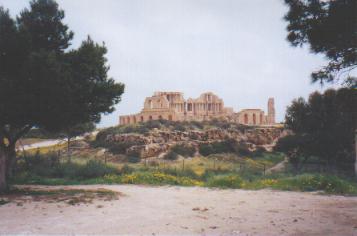 On
Thursday we asked about the price of fuel and were told that diesel was
cheaper than water! At US$0.05 per litre, it cost us $9 to fill our 180L
fuel tank!! After gleefully paying for the fuel, we visited the Roman ruins
at Sabratah, on the coast about 100Km west of Tripoli. The ruins are claimed
by some to be the "most beautiful in the world". The town was founded by
the Phoenicians as a port and is the source of some of the best known mosaics
in the world. We spent several hours walking through the amphitheater,
admiring the artistry of the Herculean Temple, and puzzling the plumbing
of the Oceanus Baths and the public Latrines! The city was destroyed in
647AD. We missed going to the museum as it was closed for the Feast of
Abraham – the day the Muslims celebrate the day Abraham sacrificed the
lamb provided by God in place of his son.
On
Thursday we asked about the price of fuel and were told that diesel was
cheaper than water! At US$0.05 per litre, it cost us $9 to fill our 180L
fuel tank!! After gleefully paying for the fuel, we visited the Roman ruins
at Sabratah, on the coast about 100Km west of Tripoli. The ruins are claimed
by some to be the "most beautiful in the world". The town was founded by
the Phoenicians as a port and is the source of some of the best known mosaics
in the world. We spent several hours walking through the amphitheater,
admiring the artistry of the Herculean Temple, and puzzling the plumbing
of the Oceanus Baths and the public Latrines! The city was destroyed in
647AD. We missed going to the museum as it was closed for the Feast of
Abraham – the day the Muslims celebrate the day Abraham sacrificed the
lamb provided by God in place of his son.
We bypassed Tripoli and camped off the road that night just before Leptis
Magna [according to the GPS, at 32 degrees, 41 minutes N and 14 degrees,
5 minutes E] amongst some pine trees. It was a delightful spot with ample
firewood. During the night we had a very light shower, the first rain since
leaving Australia.
 It's
hard to escape feeling at home as many of the roads are lined with eucalyptus
trees. We have also seen a number of plantations of eucalyptus trees as
well as a lot of wattle trees in blossom. We've seen these Australian trees
in all the countries we've travelled through.
It's
hard to escape feeling at home as many of the roads are lined with eucalyptus
trees. We have also seen a number of plantations of eucalyptus trees as
well as a lot of wattle trees in blossom. We've seen these Australian trees
in all the countries we've travelled through.
Yesterday we spent most of the day exploring the expansive ruins of
Leptis Magna. One of the beauties of Libya is the lack of tourists and
therefore the lack of restrictions in such places as Leptis Magna. We had
the freedom to explore the ruins to our hearts contents. The ancient town
of Leptis Magna was so big, the ruins are so awesome, that it is hard to
take it all in. Max and Sheila have visited numerous ruins throughout Europe
and reckon the sites we have seen in Libya and Tunisia are far more impressive.
One of the guidebooks says that Leptis Magna is the "best Roman site in
the Mediterranean".
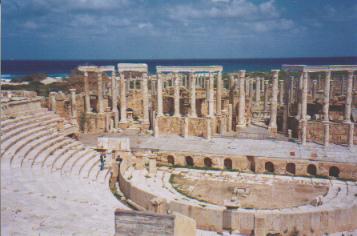 The
two Roman ruins we've seen in Libya are just so impressive they have to
be seen to be appreciated. We don't have the words to describe them. After
spending most of the day here, we ended up camping at the same pine tree
campsite we stayed at the previous night. The nights in Africa have been
cool and the days very pleasant. When we woke up this morning there was
not a cloud in the sky, but it was the coldest we've had in Africa (8 degrees
C) yet the day has turned out to be the warmest we've had (low 20's).
The
two Roman ruins we've seen in Libya are just so impressive they have to
be seen to be appreciated. We don't have the words to describe them. After
spending most of the day here, we ended up camping at the same pine tree
campsite we stayed at the previous night. The nights in Africa have been
cool and the days very pleasant. When we woke up this morning there was
not a cloud in the sky, but it was the coldest we've had in Africa (8 degrees
C) yet the day has turned out to be the warmest we've had (low 20's).
Today Saturday 18 March we arrived in Tripoli, the capital of Libya.
As we've not had a shower since leaving Tunis, we had no choice but to
spend a night in a hotel. We are staying at the Bab El Madinah, on the
Mediterranean in the centre of town within walking distance from the old
fort and markets. In the past, hotels in Libya have been very expensive.
However, since the currency has been devalued, prices are now very reasonable.
It cost us US$20 for a double room overlooking the Mediterranean with secure
parking. We changed money on the black market before entering Libya, but
found the official rate at the banks in Tripoli to be similar [1.9 Libyan
dinar to 1 US$]. We have found the prices in Libya and Tunisia to be very
cheap, especially compared to European prices.
We are sending this email from an Internet cafe in Tripoli. It is very
large and has in the order of two dozen computers in a modern office. It
cost only US$2.50 per hour. In Tunis and Marseille it was difficult to
type because the keyboards were not in English, where as here in Tripoli
the keyboards are in English. We are constantly amazed by the number of
Africans using the Internet.
Despite its reputation, Libya is an extremely safe place. In the four
days we've been here, we have only seen guns twice -- one soldier at the
entrance of an army base and two policemen at the entrance to a museum.
We saw far more guns in Italy and Tunisia than we have seen here. The locals
have been extremely friendly and many of them speak very good English.
Everyone we've met has been very keen for foreigners to realise that Libya
is a safe and beautiful country to visit -- which is certainly our experience.
All the officials we've met have also been friendly and courteous. About
the only criticism we have of the country is that it needs an anti-litter
campaign.

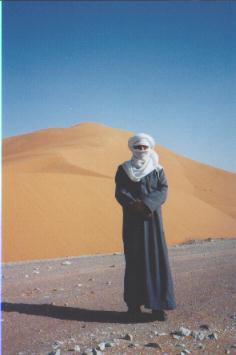
After leaving Tripoli, we headed southwest to Ghadames via Yfren and
Nalut along a good bitumen highway. About 100 km out of Tripoli, the highway
climbed to the top of a mountain range that extends from the coast just
east of Tripoli all the way to Tunisia. On leaving Tripoli, the countryside
was green and populated, but eventually gave way to desolate desert country
the closer we got to Ghadames. At Nalut we went to the immigration office
to have our passports stamped. As the forms were all in Arabic, a local
who was in the office renewing his passport invited us into his home for
a cup of tea while he filled in the forms for us. This has been typical
of the friendship shown to us by the people of Libya.
In Ghadames we visited the old town which is now on the World Heritage
list. It was fascinating to walk through the narrow alleyways and the multi-storied
mud-brick houses. Contained within the wall of the old town were numerous
date palms and small farming plots, with plentiful water supplied from
the vast artesian basin. It was only recently that everyone was relocated
into modern housing surrounding the old town. We spent a couple of days
in Ghadames, made all the more delightful by spending time with three local
guys who befriended us.
 We
left Ghadames for Ghat along the Algerian border with our permit and compulsory
guide. Ali was a Tuareg tribesman who grew up travelling the old trade
route with his father back in the camel days. We spent four days covering
the 720 km, some of which passed through Algeria. The countryside was diverse.
Some areas were flat, while others were undulating plains of gravel or
sand. There were several mountain ranges, numerous "wadis" (dry creek beds)
that often widened out into plains. But best of all was the sand dune country!
One night we spent camped inside Algeria on top of the tallest sand dune
we could find (about 175 metres high). Along the way we saw some rock carvings,
a salt lake, a small oasis lined with palm trees that is being overtaken
by a large sand dune, a large petrified tree, and a number of Algerian
oil fields clearly visible from the Libyan side of the border.
We
left Ghadames for Ghat along the Algerian border with our permit and compulsory
guide. Ali was a Tuareg tribesman who grew up travelling the old trade
route with his father back in the camel days. We spent four days covering
the 720 km, some of which passed through Algeria. The countryside was diverse.
Some areas were flat, while others were undulating plains of gravel or
sand. There were several mountain ranges, numerous "wadis" (dry creek beds)
that often widened out into plains. But best of all was the sand dune country!
One night we spent camped inside Algeria on top of the tallest sand dune
we could find (about 175 metres high). Along the way we saw some rock carvings,
a salt lake, a small oasis lined with palm trees that is being overtaken
by a large sand dune, a large petrified tree, and a number of Algerian
oil fields clearly visible from the Libyan side of the border.
We reached the bitumen again just before Ghat where we spent two nights
in a campground where we were able to enjoy hot showers and restaurant
meals within sight of the Akakus mountain escarpment. The day before we
arrived in Ghat, we had broken the main front leaf spring, so our first
task was to get this welded. Does the OME (Old Man Emu) heavy duty leaf
spring warranty cover two years on African roads? In Ghat we strolled through
the old mud-brick town and climbed the hill for a look at the fort the
Italians built during the war, stocked up with fresh fruit and vegies,
topped up the water and fuel tanks, and got our permit to travel through
the World Heritage Akakus mountains.

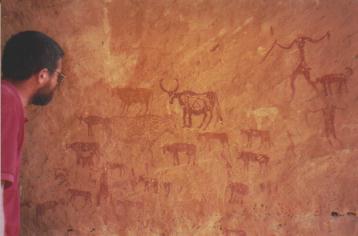
 Continuing
on with Ali as our compulsory guide, we spent five days winding our way
through the ever changing and absolutely stunning scenery of the Akakus
mountains, pausing on numerous occasions to look at rock carvings and paintings,
some of which are reputed to date back 10,000 years. Words are not enough
to describe the beauty of the Akakus region with its sand dunes back-dropped
by rugged mountains and bizarre rock formations.
Continuing
on with Ali as our compulsory guide, we spent five days winding our way
through the ever changing and absolutely stunning scenery of the Akakus
mountains, pausing on numerous occasions to look at rock carvings and paintings,
some of which are reputed to date back 10,000 years. Words are not enough
to describe the beauty of the Akakus region with its sand dunes back-dropped
by rugged mountains and bizarre rock formations.
It was sad when we set foot back on the bitumen and said goodbye to
Ali who had been our guide, friend and companion for the past eleven days.
From Serdeles we headed north east to a campground just outside Germa.
After having a shower, stocking up with fresh supplies, and lowering the
tyre pressure, we headed north into the "sand sea" dune country to visit
the picture postcard Dune Lakes. The drive was a real buzz and a lot of
fun for the driver (Geoff) but a bit stressful for his passengers! It was
all that you imagine of the Sahara. Driving in a Saharan sand sea is very
different from driving in Australian deserts. As a whole the sane dunes
are much firmer, irregular, taller and vast!
We first stopped at the Mandara oasis where we strolled around the lake
and enjoyed lunch under the shade of a eucalyptus tree overlooking the
lake, fringed by palm treees. As is typical of Africa, where ever people
have lived in Libya, you find an abundance of Australian eucalyptus or
gum trees. Palm trees look nice, but for firewood and shade, you can't
beat our trees! After lunch we drove to the oasis of Um el Ma, where we
camped for the night. This lake is called the "Mother of the Waters", although
we think it would have been better called the "Mother of Flies"! The afternoon
sun was very hot, but the view of the lake with the reflection of the palm
trees against the setting sun was fabulous. The spring fed lake is 200
metres long and 50 metres at its widest point and is the prettiest of all
the lakes. We were tempted to go for a swim, but as the water was salty,
we didn't relish the thought of sleeping with crackly skin.
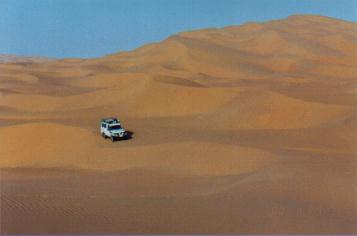
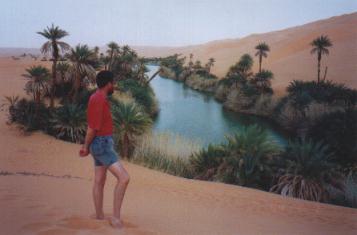
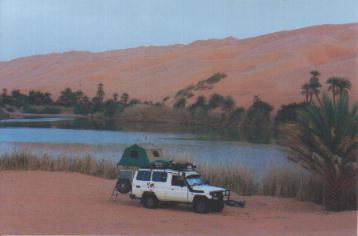 The
next day we continued over the sand dunes to the Gabrun oasis, the biggest
of the lakes. We had a relaxing afternoon strolling through the old abandoned
village and having a snooze under the eucalyptus trees. The village was
most interesting, considering the people had moved out only ten years ago.
During the day the clouds built up, and as we were sitting down for tea,
it began to rain... well, a few drops fell out of the sky. We later heard
that Ghat had had two days of rain.
The
next day we continued over the sand dunes to the Gabrun oasis, the biggest
of the lakes. We had a relaxing afternoon strolling through the old abandoned
village and having a snooze under the eucalyptus trees. The village was
most interesting, considering the people had moved out only ten years ago.
During the day the clouds built up, and as we were sitting down for tea,
it began to rain... well, a few drops fell out of the sky. We later heard
that Ghat had had two days of rain.
On leaving the next morning the temperature skyrocketed, reaching 38
degrees, blown in by strong winds. The drive back to Germa gave us our
first taste of a sand storm. The surface of the dunes was awash with billowing
sand and navigation was difficult due to the reduced visibility and the
fact that the tracks were being quickly obliterated. Back at the campground,
we enjoyed a lengthy shower, removing the sand from our eyes, ears, hair
and beard...
The next day, in spite of the heat, we spent the morning driving in
air conditioned comfort to Wadi Mathendous. This is a relatively small
dry creek bed in the middle of a plain covered with black basalt boulders
that is home to a 200 metre long fantastic gallery of 10,000 year old rock
carvings. Despite the 41 degree heat, we spent an hour and a half viewing
the many engravings before heading back once again to the campground near
Germa.
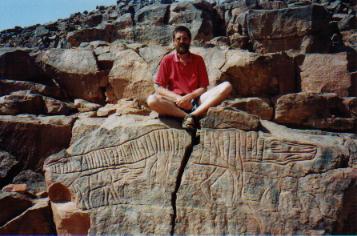 We
woke the next day to much cooler temperatures and set off for Waw en Namus,
some 600 km to the south east. We left the bitumen at Timsah, reduced the
tyre pressure and travelled through the Timsah Sands. We then followed
a formed dirt road that was so corrugated that we made our own track across
the plain. The final 150 km was bush tracks across gravel and sandy plains.
This area was the most desolate we have travelled through. Apart from a
few trees in one wadi, we saw no signs of vegetation until we reached the
top of the volcanic rim of the Waw en Namus crater and looked down upon
three lakes rimmed with tall reeds and palm trees. After driving around
the 11 km rim, we had a most enjoyable time exploring the depths of the
crater on foot. On the way back we had a most unusual sensation crossing
the Timsah Sands. The surface was totally obscured by blowing sand, giving
us the feeling of floating in mid air with the engine racing itself, always
rising higher as though we were about to take off. Between the end of Troopy's
white bonnet and the grey sky was nothing but the pale yellow colour of
the blowing sand. It was only an occasional blade of grass or marker pole
that gave any sense of orientation or speed.
We
woke the next day to much cooler temperatures and set off for Waw en Namus,
some 600 km to the south east. We left the bitumen at Timsah, reduced the
tyre pressure and travelled through the Timsah Sands. We then followed
a formed dirt road that was so corrugated that we made our own track across
the plain. The final 150 km was bush tracks across gravel and sandy plains.
This area was the most desolate we have travelled through. Apart from a
few trees in one wadi, we saw no signs of vegetation until we reached the
top of the volcanic rim of the Waw en Namus crater and looked down upon
three lakes rimmed with tall reeds and palm trees. After driving around
the 11 km rim, we had a most enjoyable time exploring the depths of the
crater on foot. On the way back we had a most unusual sensation crossing
the Timsah Sands. The surface was totally obscured by blowing sand, giving
us the feeling of floating in mid air with the engine racing itself, always
rising higher as though we were about to take off. Between the end of Troopy's
white bonnet and the grey sky was nothing but the pale yellow colour of
the blowing sand. It was only an occasional blade of grass or marker pole
that gave any sense of orientation or speed.
It was with great sadness that we hit the bitumen and realised that
our time in the Sahara was at an end. We drove back to Tripoli via Sebha,
Hun and Sirte and camped on the Mediterranean Sea. We have had a fantastic
month in Libya. It has met and indeed exceeded our every expectation. The
people are so very friendly, the vastness of the desert is awesome, the
sand dune country is out of this world, and the country is so safe and
secure. It's unfortunate that Libya has such an undeserved reputation.
From here we head back to Tunisia where we have another week before
catching the ferry to Sicily and our flight back to Australia. We're really
enjoying travelling with Max and Sheila, and we have all kept well, no
doubt in part due to Sheila's good cooking. It has been a magnificent trip.
Best Wishes from Tripoli,
Geoff Kingsmill and John Sandefur
UPDATE MAY-2000
Getting a VISA for Libya
To get a Libyan visa citizens of most countries
require an invite. Whils this sounds daunting it's actually relatively
straight forward. Most tour agents in Libya can do this for you, its just
a matter of finding one. The easiest way is to contact Azar
Tours using Email or Fax who can arrange the invite for you. They cater
for
independant travellers and so you are not required to join one of their
tours. They charge US$100.
You'll also need to get the first page of your
passport translated into Arabic. If you are in Europe contact your nearest
Libyan Embassy. As we live in Australia we got our passports translated
in Australia and had Azar Tours send our invite to the Libyan Consulate
in Tunis. On arrival in Tunisia, our Libyan Visa was processed overnight.
All very straightforward and with the minimum of fuss. Chris Scott has
details on how to get a Libyan Visa in the UK on his Sahara
Travel Information WEB page.
Taking a vehicle into Libya
If you do not have a Carnet-du-Passage then a
Local Libyan Carnet-du-Passage can be purchased at the border. You will
also be required to buy compulsary third party vehicle insurance and rent
a set of vehicle registration number plates. Expect to pay around US$250
in total. Formalities will probably take around two to three hours.
Books
Chris Scott's "Sahara Overland - A route and planning
guide" book is recommended and contains detailed information on overland
travel through Libya. If you look closely you'll even see a few pictures
of Troopy. His Sahara Travel
Information Web page contains all the latest information to compliment
the book.
Libyan Tourist Office
The Libyan Tourist
Information and Promotion Board is in the process of setting up a WEB
page. If you are after tourist information you can also contact them via
Email.
The person in charge of the Tourist Information speaks very good English
and I'm sure he would be very helpful of you need more information. They
also publish a number of good books and excellent posters. I assume that
these will all appear on their WEB page when its up and running.


 On
Thursday we asked about the price of fuel and were told that diesel was
cheaper than water! At US$0.05 per litre, it cost us $9 to fill our 180L
fuel tank!! After gleefully paying for the fuel, we visited the Roman ruins
at Sabratah, on the coast about 100Km west of Tripoli. The ruins are claimed
by some to be the "most beautiful in the world". The town was founded by
the Phoenicians as a port and is the source of some of the best known mosaics
in the world. We spent several hours walking through the amphitheater,
admiring the artistry of the Herculean Temple, and puzzling the plumbing
of the Oceanus Baths and the public Latrines! The city was destroyed in
647AD. We missed going to the museum as it was closed for the Feast of
Abraham – the day the Muslims celebrate the day Abraham sacrificed the
lamb provided by God in place of his son.
On
Thursday we asked about the price of fuel and were told that diesel was
cheaper than water! At US$0.05 per litre, it cost us $9 to fill our 180L
fuel tank!! After gleefully paying for the fuel, we visited the Roman ruins
at Sabratah, on the coast about 100Km west of Tripoli. The ruins are claimed
by some to be the "most beautiful in the world". The town was founded by
the Phoenicians as a port and is the source of some of the best known mosaics
in the world. We spent several hours walking through the amphitheater,
admiring the artistry of the Herculean Temple, and puzzling the plumbing
of the Oceanus Baths and the public Latrines! The city was destroyed in
647AD. We missed going to the museum as it was closed for the Feast of
Abraham – the day the Muslims celebrate the day Abraham sacrificed the
lamb provided by God in place of his son.
 It's
hard to escape feeling at home as many of the roads are lined with eucalyptus
trees. We have also seen a number of plantations of eucalyptus trees as
well as a lot of wattle trees in blossom. We've seen these Australian trees
in all the countries we've travelled through.
It's
hard to escape feeling at home as many of the roads are lined with eucalyptus
trees. We have also seen a number of plantations of eucalyptus trees as
well as a lot of wattle trees in blossom. We've seen these Australian trees
in all the countries we've travelled through.
 The
two Roman ruins we've seen in Libya are just so impressive they have to
be seen to be appreciated. We don't have the words to describe them. After
spending most of the day here, we ended up camping at the same pine tree
campsite we stayed at the previous night. The nights in Africa have been
cool and the days very pleasant. When we woke up this morning there was
not a cloud in the sky, but it was the coldest we've had in Africa (8 degrees
C) yet the day has turned out to be the warmest we've had (low 20's).
The
two Roman ruins we've seen in Libya are just so impressive they have to
be seen to be appreciated. We don't have the words to describe them. After
spending most of the day here, we ended up camping at the same pine tree
campsite we stayed at the previous night. The nights in Africa have been
cool and the days very pleasant. When we woke up this morning there was
not a cloud in the sky, but it was the coldest we've had in Africa (8 degrees
C) yet the day has turned out to be the warmest we've had (low 20's).


 We
left Ghadames for Ghat along the Algerian border with our permit and compulsory
guide. Ali was a Tuareg tribesman who grew up travelling the old trade
route with his father back in the camel days. We spent four days covering
the 720 km, some of which passed through Algeria. The countryside was diverse.
Some areas were flat, while others were undulating plains of gravel or
sand. There were several mountain ranges, numerous "wadis" (dry creek beds)
that often widened out into plains. But best of all was the sand dune country!
One night we spent camped inside Algeria on top of the tallest sand dune
we could find (about 175 metres high). Along the way we saw some rock carvings,
a salt lake, a small oasis lined with palm trees that is being overtaken
by a large sand dune, a large petrified tree, and a number of Algerian
oil fields clearly visible from the Libyan side of the border.
We
left Ghadames for Ghat along the Algerian border with our permit and compulsory
guide. Ali was a Tuareg tribesman who grew up travelling the old trade
route with his father back in the camel days. We spent four days covering
the 720 km, some of which passed through Algeria. The countryside was diverse.
Some areas were flat, while others were undulating plains of gravel or
sand. There were several mountain ranges, numerous "wadis" (dry creek beds)
that often widened out into plains. But best of all was the sand dune country!
One night we spent camped inside Algeria on top of the tallest sand dune
we could find (about 175 metres high). Along the way we saw some rock carvings,
a salt lake, a small oasis lined with palm trees that is being overtaken
by a large sand dune, a large petrified tree, and a number of Algerian
oil fields clearly visible from the Libyan side of the border.


 Continuing
on with Ali as our compulsory guide, we spent five days winding our way
through the ever changing and absolutely stunning scenery of the Akakus
mountains, pausing on numerous occasions to look at rock carvings and paintings,
some of which are reputed to date back 10,000 years. Words are not enough
to describe the beauty of the Akakus region with its sand dunes back-dropped
by rugged mountains and bizarre rock formations.
Continuing
on with Ali as our compulsory guide, we spent five days winding our way
through the ever changing and absolutely stunning scenery of the Akakus
mountains, pausing on numerous occasions to look at rock carvings and paintings,
some of which are reputed to date back 10,000 years. Words are not enough
to describe the beauty of the Akakus region with its sand dunes back-dropped
by rugged mountains and bizarre rock formations.


 The
next day we continued over the sand dunes to the Gabrun oasis, the biggest
of the lakes. We had a relaxing afternoon strolling through the old abandoned
village and having a snooze under the eucalyptus trees. The village was
most interesting, considering the people had moved out only ten years ago.
During the day the clouds built up, and as we were sitting down for tea,
it began to rain... well, a few drops fell out of the sky. We later heard
that Ghat had had two days of rain.
The
next day we continued over the sand dunes to the Gabrun oasis, the biggest
of the lakes. We had a relaxing afternoon strolling through the old abandoned
village and having a snooze under the eucalyptus trees. The village was
most interesting, considering the people had moved out only ten years ago.
During the day the clouds built up, and as we were sitting down for tea,
it began to rain... well, a few drops fell out of the sky. We later heard
that Ghat had had two days of rain.
 We
woke the next day to much cooler temperatures and set off for Waw en Namus,
some 600 km to the south east. We left the bitumen at Timsah, reduced the
tyre pressure and travelled through the Timsah Sands. We then followed
a formed dirt road that was so corrugated that we made our own track across
the plain. The final 150 km was bush tracks across gravel and sandy plains.
This area was the most desolate we have travelled through. Apart from a
few trees in one wadi, we saw no signs of vegetation until we reached the
top of the volcanic rim of the Waw en Namus crater and looked down upon
three lakes rimmed with tall reeds and palm trees. After driving around
the 11 km rim, we had a most enjoyable time exploring the depths of the
crater on foot. On the way back we had a most unusual sensation crossing
the Timsah Sands. The surface was totally obscured by blowing sand, giving
us the feeling of floating in mid air with the engine racing itself, always
rising higher as though we were about to take off. Between the end of Troopy's
white bonnet and the grey sky was nothing but the pale yellow colour of
the blowing sand. It was only an occasional blade of grass or marker pole
that gave any sense of orientation or speed.
We
woke the next day to much cooler temperatures and set off for Waw en Namus,
some 600 km to the south east. We left the bitumen at Timsah, reduced the
tyre pressure and travelled through the Timsah Sands. We then followed
a formed dirt road that was so corrugated that we made our own track across
the plain. The final 150 km was bush tracks across gravel and sandy plains.
This area was the most desolate we have travelled through. Apart from a
few trees in one wadi, we saw no signs of vegetation until we reached the
top of the volcanic rim of the Waw en Namus crater and looked down upon
three lakes rimmed with tall reeds and palm trees. After driving around
the 11 km rim, we had a most enjoyable time exploring the depths of the
crater on foot. On the way back we had a most unusual sensation crossing
the Timsah Sands. The surface was totally obscured by blowing sand, giving
us the feeling of floating in mid air with the engine racing itself, always
rising higher as though we were about to take off. Between the end of Troopy's
white bonnet and the grey sky was nothing but the pale yellow colour of
the blowing sand. It was only an occasional blade of grass or marker pole
that gave any sense of orientation or speed.